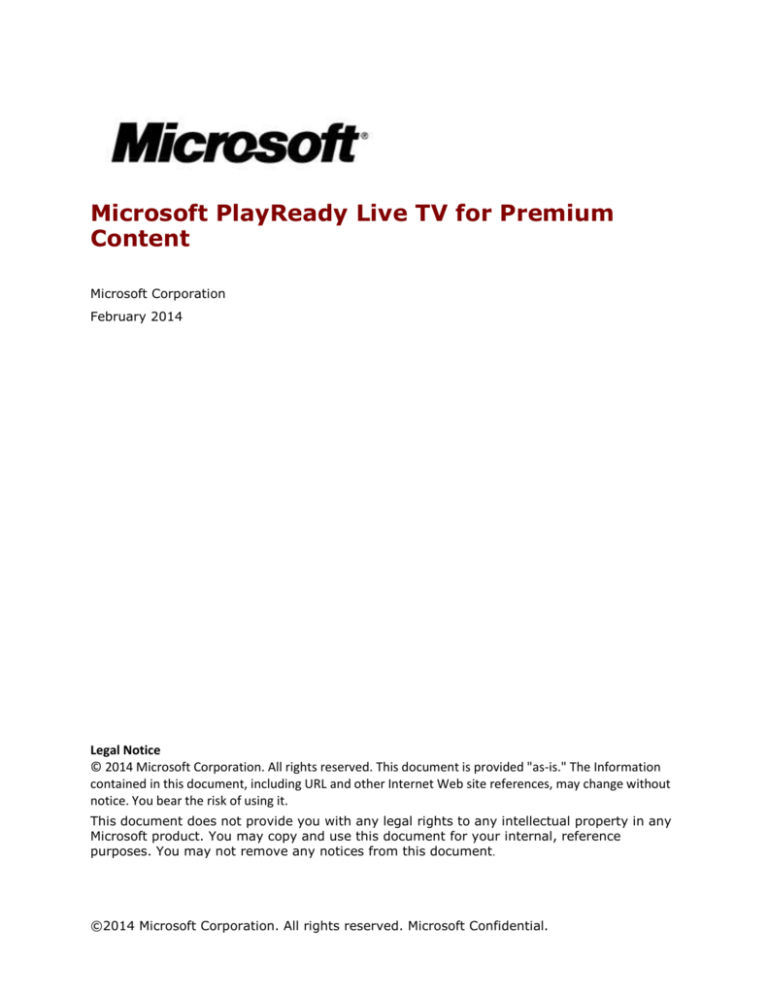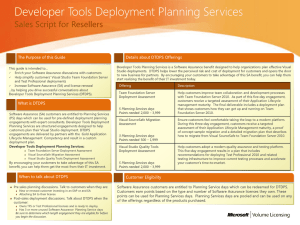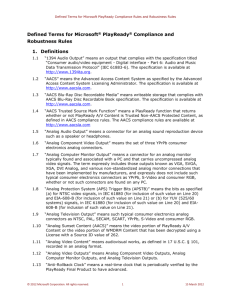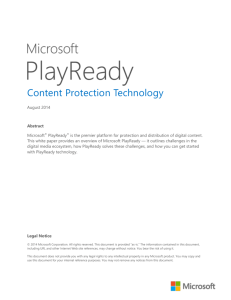
Microsoft PlayReady Live TV for Premium
Content
Microsoft Corporation
February 2014
Legal Notice
© 2014 Microsoft Corporation. All rights reserved. This document is provided "as-is." The Information
contained in this document, including URL and other Internet Web site references, may change without
notice. You bear the risk of using it.
This document does not provide you with any legal rights to any intellectual property in any
Microsoft product. You may copy and use this document for your internal, reference
purposes. You may not remove any notices from this document.
©2014 Microsoft Corporation. All rights reserved. Microsoft Confidential.
Microsoft PlayReady Live TV for Premium content
1 Introduction
We're at the beginning of a major historical shift from watching live TV to watching video,
including TV shows and movies on mobile devices and TVs. Even live sports and events are
now being streamed to all devices. Broadcast and broadband web media is merging. And
as customers enjoy consuming their content on TVs, laptops, tablets and smartphones,
Microsoft enables and protects premium content so that service providers and content
providers can create successful business models.
PlayReady is Microsoft’s content protection technology that enables and protects premium
video and Live TV across desktops, TVs, mobile devices and platforms including Windows,
iOS and Android. PlayReady is the world’s most deployed DRM, and it combines studiograde content protection with a massive ecosystem reach to enable a variety of content
streams and business models, including HD, DASH, HTML5, and purchase, rental and
subscription. Its customers are top-tier cable operators, IPTV providers, mobile network
operators and content owners. The vast PlayReady partner ecosystem include mobile, TV,
STB manufacturers; silicon providers, media encoders, system integrators, cloud based
ASPs and online video platforms.
In 2011, Microsoft PlayReady Premium was launched running on Microsoft IIS Media
Services with automatic key rotation and blackout support. In 2013, Microsoft PlayReady
LiveTV was launched to be fully integrated into a wider ecosystem, including third party
encoder and packager vendors. PlayReady Live TV provides a solution for Linear TV which
maps constructs from a managed service for on over-the-top service. These features
include highly frequent key rotation, blackout signaling, as well as hyper localized ad
insertion. The purpose of this paper is to provide an overview of the interfaces and
protocols available to integrate PlayReady LiveTV.
©2014 Microsoft Corporation. All rights reserved. Microsoft Confidential.
Page 2
Microsoft PlayReady Live TV for Premium content
VoD and LiveTV Licensing have different license policy requirements
PlayReady 2.0 enabled content providers to apply specific policies to encrypted content.
These policies are typically associated with a single license, where the content policy and
the content key are part of a single license. In this scenario, when a license is requested for
video on demand (VOD) content, regardless of how services map users to content they have
access to, the licenses they create are independent of licenses created for other users. That
is to say, license generation for one user is not affected by license generation for another
user, and thus no forethought for license generation is required from a mechanical
standpoint. This model is still supported in all PlayReady versions for VOD content.
However, Live TV scenarios introduce new challenges on how policies and licenses are
managed across the system. In those scenarios, both content keys and policies can change
at any point in the stream and client applications need to enforce those policies in real time.
It typically requires that keys are rotated often for more robust security or contractual
requirements. Meeting this requirement creates two primary challenges to overcome:
1. An extremely large amount of licenses need to be issued, resulting in the following
problems:
a. The computation time on the server to generate licenses increases dramatically,
creating scalability problems. This is the most important problem to overcome.
b. Network traffic for license acquisitions increases greatly, which also compounds
c. The client side disk storage for licenses can grow inordinately large.
2. Computational complexity for decryptor context creation on the client, as well as the
act of decryption, rises significantly with heavily rotated keys. The former is further
exasperated without a solution for the first challenge listed above. Note that the Client
side details are discussed further in the PlayReady documentation and will not be part
of the present white paper.
These two challenges are magnified by the additional requirement of blackout: some Live TV
content (typically sporting events) require content providers to blackout certain regions
from viewing the content.
PlayReady is addressing these Live TV distribution challenges through the introduction of:
1. Scalable chained licenses scheme: scalable root license and scalable leaf licenses,
the latest being transported in-stream and signaled using ISO MPEG Common
Encryption (available in PIFF and MPEG-DASH).
2. A key derivation tree scheme: it allows for efficient key issuance since rather than
issuing all required leaf keys for all content (or channels if you will), a small "key set"
can be issued (in a scalable root license) that clients can use to derive the key to
which a leaf license is bound (that is, the key with which the leaf content key is
encrypted).
©2014 Microsoft Corporation. All rights reserved. Microsoft Confidential.
Page 3
Microsoft PlayReady Live TV for Premium content
Integrating with PlayReady
1.1 PlayReady Live TV streaming architecture
With PlayReady for Live TV a service provider will first define a master key set which defines
all the channels and regions for the service. This key set will be used as part of the leaf and
root licenses generation and enforce policies around region restrictions and channel access
for clients. Prior to streaming content, a client will request a root license which defines the
channels and regions associated with the user account. A packager will request leaf licenses
to deliver in-stream for each live channel. This provides scalable delivery of live streams by
enforcing access policies on the client. A service provider can change the master key set
frequently for a more dynamic service.
In case of PlayReady Live TV, a typical deployment architecture involves two types of
PlayReady servers:
The PlayReady Root License Server delivers scalable root licenses to the clients.
The PlayReady Leaf License Server is connected with the Packager/Encryptor
equipment.
This is illustrated in the Figure 1 below. The workflow is as follow:
1. The Encoder equipment processes the live content into multi bit rate streams (MBR).
2. The Packager/Encryptor equipment connects to the PlayReady leaf license server and
retrieves, for each given period:
a. The content keys
b. The related key identifiers
c. The related scalable leaf licenses
3. The Packager/Encryptor then:
a. Encrypts each stream
b. Inserts the scalable leaf licenses in-stream, as Protection System Specific
Header Box data (‘pssh‘ box as defined by ISO CENC for PIFF or MPEG-DASH)
4. The multi bit rate protected streams are published in the origin servers as an
adaptive bit rate audio/video asset (ABR)
5. In order to be able to playback protected live streams, the device needs to acquire a
scalable root license from the PlayReady root license server.
©2014 Microsoft Corporation. All rights reserved. Microsoft Confidential.
Page 4
Microsoft PlayReady Live TV for Premium content
Figure 1: PlayReady Live TV architecture
©2014 Microsoft Corporation. All rights reserved. Microsoft Confidential.
Page 5
Microsoft PlayReady Live TV for Premium content
1.2 Prerequisites and integration details
Note: A company does not need to be a PlayReady licensee in order to develop a
packager/encryptor that supports PlayReady LiveTV.
Packager/encryptor prerequisites are as follow:
Package an ISO MPEG Common Encryption based stream
o PIFF 1.3:
o MPEG-DASH:
Support HTTPS with mutual authentication
Engage with PlayReady team in order to get the documentation for the interface with
the PlayReady leaf license server.
Use a test PlayReady service for your development purpose, either:
o The PlayReady public test scalable license service (details in the
documentation);
o Or build your own scalable license service (for which you would need the
appropriate PlayReady license, server SDK and deployment certificate. See
documentation for details).
In this section we will take a closer look at the interface between the packager/encryptor
and the PlayReady leaf license server:
This interface is a Web method initially designed to provide the required policy information
to an encryption pipeline for packaging protected interoperable file format (PIFF) live TV
streams. At the end, it can be used similarly with any ISO MPEG Common Encryption based
live TV stream. This interface is secured through the use of an SSL connection with mutual
authentication between the packager/encryptor and PlayReady Leaf License Server. See the
Figure 2 below to understand the components interacting.
©2014 Microsoft Corporation. All rights reserved. Microsoft Confidential.
Page 6
Microsoft PlayReady Live TV for Premium content
Figure 2: Zoom on PlayReady Leaf license acquisition interface
1.3 Best Practices for Common Encryption
We actually recommend that the packager/encryptor engine follow the second edition of
Common Encryption specification, specifically as it relates to leaving NAL data in clear. This
2nd edition recommends, in section 9.6.2.1:
In this case, ‘avc1’ type bit-stream can be converted to Annex B byte stream format by adding start
codes and PPS/SPS NAL units as sequence headers. To facilitate stream reformatting before
decryption, it is required that at least the NAL length field and the nal_unit_type field (the first
byte after the length) of each NAL unit is left unencrypted, and recommended that entire slice NAL
headers be unencrypted. In addition, it should be noted that:
• The length field is a variable length field. It can be 1, 2, or 4 bytes long and is specified in the
Sample Entry for the track as the lengthSizeMinusOne field in the
AVCDecoderConfigurationRecord
•
There are multiple NAL units per sample, requiring multiple pieces of clear and encrypted data
per sample.
•
NAL units that do not contain video slice data need not be encrypted, and should not be
encrypted if they contain information that must be accessed prior to decryption, such as caption
information contained in SEI NAL units.
©2014 Microsoft Corporation. All rights reserved. Microsoft Confidential.
Page 7
Microsoft PlayReady Live TV for Premium content
Although the Common Encryption 2nd edition language is “recommended” rather “required”,
PlayReady will make this a requirement moving forward. This means:
NAL units that don’t contain audio/video data should remain entirely unencrypted
NAL units that do contain audio/video data should have the slice header left in the
clear.
©2014 Microsoft Corporation. All rights reserved. Microsoft Confidential.
Page 8
Microsoft PlayReady Live TV for Premium content
2 Conclusion
In this document we have presented how PlayReady LiveTV offers a fully scalable way to
address the unique requirements of Live TV. This is achieved through scalable license chains
(root and leaf), Region sets (blackout), and embedded license stores. These features are
supported in combination with the ISO MPEG Common Encryption based streams which is
used by the following PIFF and MPEG-DASH streams. For further reference, please review
implementation details provided:
For Microsoft Smooth Streaming, as described in Protected Interoperable File Format
(PIFF) specification.
For ISO MPEG DASH, as described in “DASH Content Protection using Microsoft
PlayReady” document.
Notice that PlayReady Live TV features are container agnostic other containers can be
supported if PlayReady compliant encryption bindings are defined for them.
Also, as it was already for Video-On-Demand scenarios, Live TV encoder/packager hardware
and software vendors have now the ability to integrate PlayReady Live TV support in their
products.
To get access to the above mentioned documents or for additional details, please contact
the PlayReady team at PlayReady@microsoft.com.
©2014 Microsoft Corporation. All rights reserved. Microsoft Confidential.
Page 9
Microsoft PlayReady Live TV for Premium content
Appendix
PlayReady Test server and sample player
A public PlayReady test server is available which provides a scalable license service that can
be used for testing and integrating with encoding solutions.
This test service provides a license handler designed for an encoder to test a variety of key
policy scenarios. This is achieved by the packager/encryptor providing a configuration of the
requested services to the license server.
Please contact playready@microsoft.com to obtain details on how to utilize the public test
server.
©2014 Microsoft Corporation. All rights reserved. Microsoft Confidential.
Page 10












